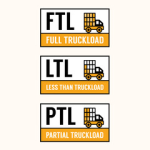
LTL vs. FTL Shipping: How to Optimize Costs for Any Load Size
September 11, 2025
Expedited Freight Services: When Time-Critical Shipping Makes Sense
September 28, 2025Part 1: The Basics of Flatbed Trucking
When your freight can’t fit neatly inside a standard dry van trailer, flatbed trucking often becomes the best option. From oversized machinery to construction materials, flatbeds provide the flexibility to handle heavy haul transport that other equipment simply can’t accommodate. But shipping on an open-deck trailer also brings unique challenges, safety requirements, and cost considerations that every shipper should understand.
In this first part, we’ll cover the fundamentals of flatbed freight, including what it is, when to use it, and how it differs from other modes.
What Is Flatbed Freight?
Flatbed freight refers to cargo moved on a flat, open-deck trailer rather than inside an enclosed trailer. Because the freight is exposed to the elements, it requires special loading, securing, and covering procedures.
Key features of flatbed trucking:
- Trailer design: Flat, level platform with no sides or roof.
- Versatility: Can handle loads that are too large, too wide, or too tall for dry vans.
- Accessibility: Freight can be loaded/unloaded from the top, side, or rear.
- Equipment options: Step-decks, double drops, and extendable trailers expand the range of what can be hauled.
This flexibility makes flatbed trucking the backbone of industries that rely on oversized freight shipping, such as construction, manufacturing, and energy.
Common Types of Freight Shipped on Flatbeds
Shippers often turn to flatbed solutions for freight that is bulky, irregular, or extremely heavy. Examples include:
- Building materials: Lumber, steel beams, concrete panels.
- Industrial equipment: Generators, compressors, turbines.
- Vehicles: Farm machinery, military equipment, oversized trucks.
- Prefabricated structures: Modular homes, storage tanks, large pipes.
Flatbeds also serve as the go-to solution for project cargo — one-time moves of specialized or outsized freight requiring custom planning.
Why Not Use Dry Van or Reefer?
Flatbed trailers solve problems that enclosed trailers cannot:
- Dimensional limits: Dry vans max out at about 53 feet in length, 102 inches in width, and 110 inches in height clearance. Flatbeds allow for wider and taller loads.
- Loading method: Forklifts and cranes can access flatbed cargo from multiple angles, unlike dry vans which are limited to dock loading.
- Weight capacity: Flatbeds are engineered for heavy haul transport, handling loads far exceeding typical palletized shipments.
For shippers facing freight outside of standard specs, flatbed is not just an option — it’s often the only option.
Safety and Compliance Considerations
Because flatbed freight is exposed and often oversized, safety and compliance are top priorities.
Load Securement
Federal Motor Carrier Safety Administration (FMCSA) regulations require cargo to be secured with chains, straps, binders, or tarps depending on the load. A single violation can result in fines or a truck being placed out of service.
Best practices:
- Use the correct number of tie-downs per weight thresholds.
- Protect sharp edges with corner protectors.
- Inspect securement at the start and every 150 miles thereafter.
Oversize/Overweight Permits
Loads that exceed state or federal size/weight limits require special permits. These permits specify the route, times of day, and whether pilot cars are required.
Weather Protection
Tarping prevents damage from rain, snow, or road debris. While tarping adds time and cost, it’s essential for freight like machinery, lumber, or anything sensitive to exposure.
Cost Factors in Flatbed Shipping
Flatbed shipping costs can vary widely based on:
- Size and weight: Heavier and larger loads require more specialized equipment and often permits.
- Route: Rural deliveries or complex routes may add time and fuel costs.
- Seasonality: Construction season often increases demand, pushing up rates.
- Special services: Tarping, escort vehicles, and cranes increase the final price.
While flatbed may seem more expensive at first glance, it’s often the only safe and compliant way to move oversized freight.
Benefits of Flatbed Freight for Shippers
Despite higher complexity, flatbed transport offers major advantages:
- Flexibility: Ability to move nearly anything, regardless of shape.
- Efficiency: Quick loading/unloading saves time at the dock.
- Capacity: Strong networks of flatbed carriers across North America.
- Project execution: Perfect for one-time, high-value, oversized shipments.
For businesses moving bulky equipment or construction-grade materials, flatbed provides a reliable path to market.
The Bottom Line
Flatbed trucking is more than just another mode of transport — it’s a specialized service that requires knowledge, planning, and the right partners. Shippers who understand the basics of flatbed trucking, oversized freight shipping, and heavy haul transport are better equipped to make cost-effective, compliant decisions.
Preparing Freight for Flatbed Shipping
Flatbed shipments require extra preparation before hitting the road. Unlike enclosed trailers, freight is exposed and must be stabilized against weather, movement, and road vibration.
Steps to prepare freight:
- Proper packaging: Use crating, shrink-wrap, or protective coverings for sensitive equipment.
- Blocking and bracing: Prevent movement during transit with braces or chocks.
- Even weight distribution: Keep the trailer balanced to avoid safety hazards.
- Protective tarping: Use fitted tarps to keep freight dry and clean.
Preparation not only protects the cargo — it prevents delays and penalties associated with failed inspections or non-compliance.
Choosing the Right Flatbed Carrier
Not all carriers specialize in oversized freight shipping. Shippers should carefully vet flatbed providers to ensure both safety and compliance.
Key considerations when selecting carriers:
- Experience: Carriers with proven track records in heavy haul transport handle complex freight with fewer errors.
- Equipment variety: From step-decks to double drops, the right trailer type ensures compliance with size limits.
- Driver training: Proper load securement requires skill and certification.
- Safety record: FMCSA safety scores provide a window into carrier reliability.
The right carrier doesn’t just move freight — they act as a partner in ensuring compliance, safety, and efficiency.
Managing Permits and Compliance
Shipping oversized or overweight freight means navigating a patchwork of state and federal regulations. Each state may have different thresholds, escort requirements, and time-of-day restrictions.
Best practices for compliance:
- Plan routes early: Account for bridge clearances, construction zones, and weight-restricted roads.
- Secure permits in advance: Missing paperwork can halt a shipment at state lines.
- Use pilot cars when required: Escorts ensure road safety and compliance with state rules.
Navigating permits is complex, but skipping steps can result in fines, delays, or worse — liability in the event of an accident.
Safety Strategies in Flatbed Freight
Safety is paramount when hauling open-deck loads. Every stakeholder — from shipper to driver — plays a role in minimizing risk.
Shipper responsibilities:
- Package and secure freight appropriately.
- Provide accurate dimensions and weight to carriers.
Carrier responsibilities:
- Follow FMCSA securement guidelines.
- Conduct pre-trip inspections and frequent en-route checks.
Driver responsibilities:
- Verify load securement at the start and every 150 miles.
- Adjust straps and chains as loads shift during transit.
Shared accountability ensures freight arrives safely, protecting both people and cargo.
Cost-Saving Strategies in Flatbed Shipping
While flatbed can be more complex than other modes, there are ways to keep expenses under control.
1. Plan Shipments Ahead of Time
Last-minute oversized shipments may require expedited permits, higher rates, or limited carrier availability. Advance planning locks in better pricing.
2. Consolidate Loads Where Possible
If multiple oversized items are going to the same location, combining them into a single flatbed reduces total cost per unit.
3. Use the Right Trailer
Paying for specialized trailers unnecessarily can inflate costs. Match freight to the correct trailer type to avoid overpaying.
4. Align with Seasonal Demand
Flatbed demand surges during construction season. If possible, schedule shipments during off-peak periods for better rates.
5. Work With a 3PL
A third-party logistics partner can leverage volume, optimize routes, and identify backhaul opportunities — all of which reduce freight costs without compromising service.
Technology and Visibility in Flatbed Freight
Technology plays a critical role in managing flatbed shipments effectively:
- Transportation Management Systems (TMS): Compare carrier rates, manage documents, and track shipments in one place.
- Load tracking: Real-time visibility into oversized freight reduces uncertainty.
- Data analysis: Identifies recurring cost drivers, helping shippers refine strategy.
For complex moves, technology ensures compliance and keeps everyone aligned.
How Swivel Simplifies Flatbed Shipping
At Swivel, we understand the unique challenges of flatbed trucking. Our solutions are designed to help shippers move oversized freight safely, compliantly, and cost-effectively.
With Swivel, shippers gain:
- Carrier network access: Flatbed specialists with the right trailers and experience.
- Permit management support: Assistance in navigating state and federal requirements.
- Data-driven decisions: Insight into when flatbed, step-deck, or other specialized equipment is most cost-effective.
- Technology tools: Real-time tracking and reporting for full visibility.
Whether it’s a single oversized load or recurring heavy haul transport, Swivel ensures your freight moves safely and efficiently.
Final Takeaway
Flatbed shipping may seem daunting, but with the right preparation, partners, and strategy, it becomes an indispensable tool for industries moving oversized and heavy loads. By focusing on safety, compliance, and cost control, shippers can leverage flatbed’s flexibility without overspending.
From building materials to industrial equipment, flatbed trucking powers the backbone of commerce. With Swivel’s expertise, you can approach every shipment with confidence, knowing your freight is secure, compliant, and moving at the best possible cost.

